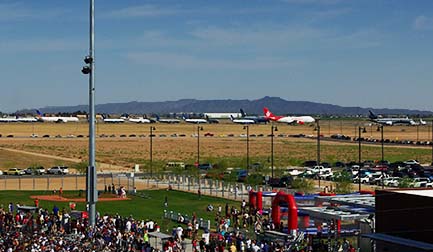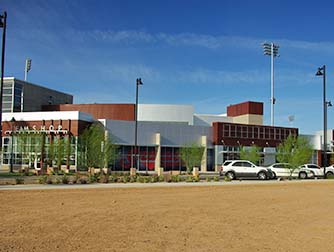Article and all photos by Joe Mock, BaseballParks.com
All rights reserved
 |
Everyone I had talked to about the new spring training complex in Goodyear, Arizona always seemed to use the same phrase to describe it: a place like no other. This was true when I talked to Dave Bower, the head of spring training and minor league ballpark design at HOK Sport, which designed the complex. This was true when I spoke with Nathan Torres, Ballpark Manager for the City of Goodyear. This was also true of Debbie Diveney, the Ballpark Supervisor.
| Ballpark Stats |
 |
| Team: The Cleveland Indians conduct spring training here, and the Cincinnati Reds will join them in 2010 |
| First game: Feb. 25 , 2009 — a 10-7 loss to the Giants |
| Capacity: 10,311, which includes room for 1,530 on the berms |
| Architect: HOK Sport (now known as Populous) |
| Construction: Barton Malow |
| Price: $108 million for the entire complex |
| Home dugout: First base side (for the Indians. The Reds will probably use the third-base side) |
| Field points: Northeast |
| Playing surface: natural grass |
| Betcha didn’t know: A full year before the Reds’ arrival, their logo is already on the scoreboard and on top of the third-base dugout |
By the time I had a chance to read the marketing brochure published by the city to promote the project, I couldn’t help but notice that its cover contained only these words: “Goodyear Ballpark and Recreational Complex. Like No Other.” Well, I was convinced that everyone there believed that this was indeed a place like no other. But did I agree?
The moment I approached the completed ballpark for the first time, I became a believer. The main entryway was stunning, unlike anything I’d ever seen. And there was more astonishment on the inside.
Before we start our examination of this ballpark, let me admit that the first time I’d ever heard of Goodyear, Arizona was in 2004, when I read that the owner of the Angels wasn’t happy with the state of Tempe Diablo Stadium. It seemed that he was threatening to move the team’s spring operations to a to-be-built complex in Goodyear because he owned land there. Local residents actually voted in favor of the funding for a spring complex.
As these things often go, the City of Tempe took the threat seriously, and quickly agreed to seriously upgrade Tempe Diablo. But the seed had been planted that the western edge of the Phoenix metro area could support more springtime teams than the four already in Peoria and Surprise.
The City of Glendale, just to the north of Goodyear, had already been making national news with the construction of a hockey arena for the NHL’s Coyotes and the planning of a retractable-roof stadium for the Cardinals of the NFL. There was word that they were also scheming to bring spring training to the southwestern corner of the Valley of the Sun, and the mighty Dodgers were interested.
Goodyear wasn’t going to be outdone. In a masterful series of moves, the city that was founded by Goodyear Tire & Rubber Company’s Paul Litchfield in 1917 and that has annexed its way to encompassing an astonishing 188 square miles, was going to make wonderful use of one or two of those square miles on a baseball complex like no other. Selecting a completely undeveloped tract (that had been cotton fields) just on the west side of their city airport, an incredible master plan for residences, stores, restaurants, hotels and, oh yes, a baseball facility would unfold.
To ensure the facility would be completely ready long before the February 2009 start of spring training, the architecture, engineering, traffic planning and, most importantly, construction began far in advance. I always found it funny that each time I visited the sites in Goodyear and Glendale over the past couple of years, Goodyear was clearly well ahead of their neighbors just to the north.
In particular, during spring training in 2008, I marveled at the construction that had already taken place near the airport in Goodyear, while in Glendale, they were still pushing dirt around with no structures in sight.
To be fair, the Dodgers and White Sox moved into a completely finished complex in Glendale in February. It took round-the-clock workshifts to make that happen, though, which no doubt helped push the total pricetag through the desert stratosphere there. To the contrary, Goodyear’s project seemed to maintain a steady schedule that reflected the incredible planning that had been employed early on. And when the first Indians games were played there, all of the prep work (widening roads, creating smooth routes for the gameday traffic, the intelligent parking arrangements) resulted in order instead of chaos. In Glendale, not all of the lanes into and out of the main parking lots were open for business, and stadium officials were urging fans to “consider alternate routes” to the ballpark to avoid gridlock.
The Setting
The setting for this complex is wonderful. I say this not only because of the views and the traffic flow to its location, but also because of the development that is planned around it — indeed, right up to the ballpark’s edge — and will undoubtedly occur. Absolutely none of that “development” was even started when the Indians’ players started smacking baseballs around in February.
Other “ballpark villages” have fallen on hard times in recent years (take St. Louis for example). There’s no doubt that the slowing economy has been partly to blame for this, and no doubt this has delayed some projects in Goodyear … although the City of Goodyear didn’t use that as an excuse to cut corners on the complex or fail to get it completely ready on time. The growth in the West Valley has been so meteoric that such development is inevitable, though. It might take a little longer to happen, that’s all. Goodyear, in fact, is America’s fourth-fastest growing city with a population of under 100,000 — and they project that half a million will live here by 2045. I can’t wait to visit this ballpark in future years to see how the development is progressing because I know that all of the planning that’s been put into it will result in a stunning commercial and community “neighborhood” surrounding it.
 |
Even with all of the undeveloped land surrounding the park now (the shot above shows just a small portion of the land that’s between the park and the airport), it’s still a nice site — thanks mostly to the planning by the City.
For one thing, the traffic flow works. I had always assumed that almost all of the fans driving to the games here would take Estrella Parkway directly to the park from I-10, and I feared the worst. The “worst” didn’t happen, though, largely due to the publicizing of a second route from the Interstate. It also helped that Estrella Parkway was widened to help facilitate gameday traffic. For instance, I attended the game with the largest crowd of the spring, and because I’d taken too long watching minor leaguers play at another spring-training complex that morning (and the traffic from a hugely attended air show at nearby Luke Air Force Base), I arrived in Goodyear about 50 minutes prior to gametime. I expected gridlock. There was none.
 |
Another nice aspect of the site is its view of the Estrella Mountains, which are to the south. This view is especially striking from the practice fields (above, showing where the Reds’ fields are under construction), which are a few hundred yards south of the main ballpark.
The Exterior
When I asked Debbie Diveney what her favorite aspect of the park is, she said, “the ‘wow’ factor of the entrance.” Indeed, all discussions about the outside of this park begin and end with this incredible entryway.
 > > |
While there are fairly pedestrian entry gates behind first base, third base and center field, the one behind home plate is jaw-dropping. With its fountains and landscaping, it is in the running with the main entry at the Twins’ park in Ft. Myers for the most impressive of the 26 spring-training parks.
And long before you can get a close-up look at this area, you’ll spot the towering sculpture at the front of the plaza. It is like nothing I’ve seen before. I suppose it’s what would happen if you took a ten-foot-tall baseball made of silly putty and stretched it as far as it would go. It is particularly distinctive because it works both as a sports symbol and as art, and that’s not easy to do.
At the base of this sculpture (above right) is a pool of water that then flows down stair-stepped stones. Between this and the entrance to the park is a series of very mature palm trees — a theme that is employed inside the park around the outfield.
  |
Unlike the new ballpark in nearby Glendale, the exterior in Goodyear doesn’t attempt to blow you away with its color scheme, clever architectural angles or (especially) its landscaping. The use of colors and plants from the desert works well here, as evidenced by the view of the park’s outside behind third base in the left-hand shot above. On the right side, you see the exterior on the first-base side of the main entryway. The graded dirt you see in the foreground is quite prevalent all around the stadium, as it will one day be the site of commercial development and/or multi-family residences.